Building out your van conversion is a complex process with lots of moving parts. While it’s fun to choose paint colours and flooring, one of the most important elements is actually something you never see: insulation!
*This post may contain affiliate links, as a result, we may receive a small commission (at no extra cost to you) on any bookings/purchases you make through the links in this post. As an Amazon Associate, we earn from qualifying purchases. Read our full disclosure
Ok, insulation might not be all that exciting but it’s a key player for year-round comfort. Whether you’re spending time in cold weather or beating the heat in the summer, choosing the right van insulation is critical.
There are lots of different ways to insulate your van, ranging in price and effectiveness. With so many different options, searching for the best type of insulation can be confusing, so we’ve done the work for you!
With lots of research under our belts, we’ve put together this camper van insulation guide to summarize our findings and explain what worked best in our van build.
Traveling Soon? Here is a list of our favourite travel providers and accessories to help get you ready for your upcoming trip!
Things to Consider When Insulating Your Van
Many different components make each van insulation material unique. Certain materials are best suited for specific uses and locations in your van build. Here are the things to look for when shopping for camper van insulation.
Heat Transfer
The first thing to address when selecting van insulation is understanding how insulation works and why we need it. In a nutshell, insulation is a way to control heat transfer. There are three different types of heat transfer: radiation, conduction, and convection.
All three of these heat transfer methods are present in your van, from the sun baking in through your windows to the hot cup of tea on your counter. Your goal when selecting the right insulation is to slow heat transfer by choosing materials that address all three of its different types. By slowing heat transfer, you can better maintain a comfortable temperature in your camper van.
R-Value
When shopping for insulation, you’ll see the term “R-value” a lot. R-value is the material’s resistance to the conductive flow of heat. Basically, it measures how well the material resists the three types of heat transfer mentioned above. The higher the R-value, the better the insulator the material is.
R-value is measured per inch, so a ½” foam board will only give you half of the R-value’s insulating power. Similarly, doubling up 1” boards will give you double the R-value. R-values can range anywhere from R1.0 for something like Reflectix to R40+ for the thick fiberglass insulation you’d use in a home attic.
In a house, you could stuff your walls with the highest R-value insulation you can find and call it a day. In a van conversion, you’re much more limited with space since every extra inch takes away living space. While an inch here and there doesn’t sound like a lot, it really makes a difference in such a small space.
Moisture and Mold Resistance
Condensation is an inevitable aspect of living in a van. Every time you breathe, cook, or run a heater, moisture is created when warm air meets cooler air. Unfortunately, there is no way to truly eliminate condensation, but we can select an insulation material to help mitigate it.
Some say the solution to combating moisture is to add a vapor barrier behind your insulation. Essentially, the goal here would be to protect the body of your van from any moisture created inside. While this seems like a good idea, it’s hard to seal off 100% of moisture.
If even a little moisture gets behind your vapor barrier, it gets trapped, which can be even more problematic. Your best bet here would be to opt for a breathable insulation material, like sheep wool, or an impermeable material like rigid foam board. These materials coupled with proper air ventilation offer the most effective ways to combat moisture.
You’ll also want to make sure that your insulation is mold and mildew resistant. This is a natural perk to materials like sheep wool and foam board. Stay far, far away from fibreglass insulation if you don’t want to deal with mold issues.
Price Point
The best part of a DIY conversion or campervan build is that you need far fewer materials than you would for a house. But even with fewer materials, the price of good quality insulation can still add up quickly—and it’s not an area you want to cheap out on.
Make sure that you have adequate room in your budget for insulating material. It’s not something you’ll likely ever go back and change unless you do a complete rebuild. It’s also important to realize that proper campervan insulation materials can help you save on heating and cooling costs in the future, so it’s a worthy investment.
Finding the best insulation balances cost, R-value, and space constraints.
Environmental Friendliness
Finding an environmentally friendly material makes good insulation that much better. This was an important factor for us, as we didn’t want to use cheap insulation and incorporate toxic materials into our small living space. Sheep’s wool is a great eco-friendly option, along with some other recycled materials that are common in home insulation, like cotton and cellulose.
Types of Insulation
There are countless types of insulation on the market. In this list, we’ll take a look at the best way to insulate a cargo van.
Sheep’s Wool
If you couldn’t tell already, sheep’s wool is one of our favourites. It is our preferred insulation material for the walls and ceiling. We used Havelock Wool, sheep’s wool sourced from New Zealand and proudly produced by an environmentally-conscious company.
Sheep’s wool is a fantastic insulation option due to its natural moisture control and fire resistance. It’s also known to improve air quality and help with sound dampening. The wool has millions of tiny air pockets, which trap air and regulate temperature. Just like the wool keeps sheep warm in harsh climates, it’ll do the same for your van!
NOTE: Sheep’s wool is not to be confused with rockwool insulation, a type of synthetic mineral wool insulation. Rockwool is a sheathing board that’s commonly used in home insulation.
R-Value
In general, sheep’s wool insulation ranges from R3.5-3.8 per inch. Havelock Wool has an R-value of 3.6 per inch. It’s usually sold as R7 because it is 2” thick.
Pros
Sheep’s wool is non-toxic, breathable, and naturally water-resistant. You’ll never have to worry about mold and mildew behind your van walls or moisture affecting its insulating properties. It’s natural, compostable, and easy to install.
Cons
Sheep’s wool doesn’t have the highest R-value per inch compared to some other materials on our list. Because of this, you’ll have to use more if space allows. Also, it can be tricky to track down in stores so you’ll most likely have to order online.
Where to Buy
You can purchase Havelock Wool through select local suppliers but it’s best to purchase through Havelock directly. They have great tools for camper van-specific insulating.
Reflectix
Reflectix is that shiny silver bubble wrap-type material that you often see in van conversions. While it did gain some popularity in other areas, it offers the best way to insulate van windows. This is because it is only meant to be a barrier for radiant heat, like the sun coming in through the glass.
The most important consideration when using Reflectix insulation is having an adequate air gap. If it’s pressed up against another material, it won’t work well. The reflective surface needs to interact with air in order to perform as intended. Most people don’t have an additional ¾” to spare behind their walls, which is why reflectix is not typically used for wall insulation and is more popular as a camper window insulation.
R-Value
On its own, Reflectix has a very low R-value of about 1.1 per inch. This is why it’s not intended to be used in walls or ceilings. With a proper air gap, the R-value can be closer to 3.0 per inch.
Pros
Reflectix is inexpensive, easy to find, and easy to work with for small applications. It does a great job reflecting the sun as a radiant barrier for van window insulation.
Cons
If used incorrectly, it barely provides any insulation. Also, if you boil it down to cost based on R-value, it’s not the most bang for your buck.
Where to Buy
You can purchase Reflectix by the roll at hardware stores like Home Depot or Lowe’s, or online on Amazon.
Polyiso Rigid Foam Board
Polyiso, short for polyisocyanurate, is a common choice for foam board insulation in a motorhome insulation. It comes in different thicknesses and is usually coated with a reflective material on both sides. This means that if you have the space to accommodate an air gap, you can get an impressive R7 value from these boards.
Most people opt to keep the boards close to the walls, which is done easily since the polyiso foam boards are just flexible enough to hug the curves of your van. Based on R-value, rigid board insulation offers one of the best insulation for vans.
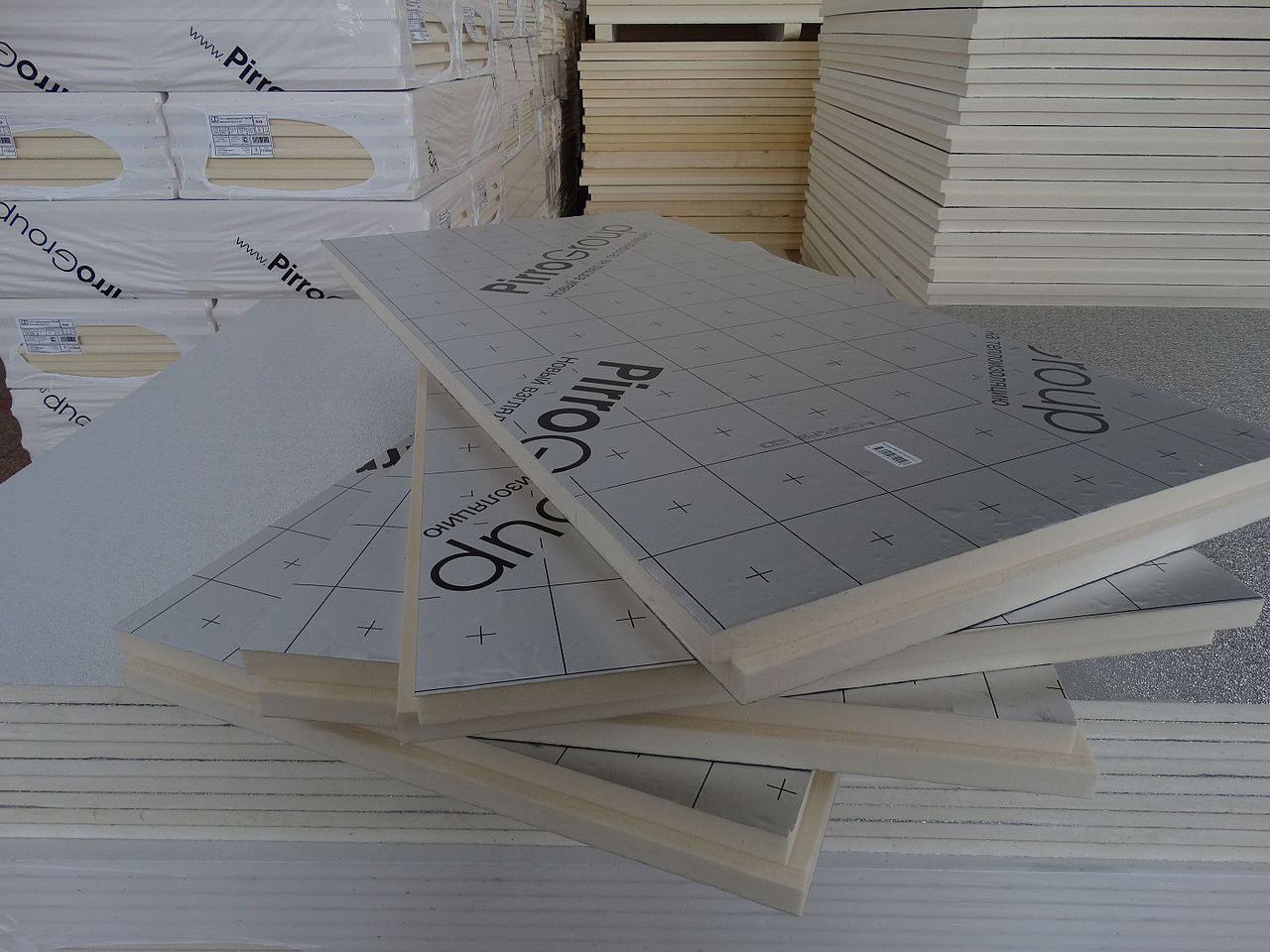
R-Value
Most polyiso rigid insulation foam boards are rated between R6.0-6.7 per inch.
Pros
Polyiso foam board insulation is a great non-toxic solution for your van build. They’re naturally impermeable to water so you won’t have to worry about mold and they’re cost-effective too.
Cons
The main drawback to insulating with polyiso is the decrease in R-value when exposed to very cold temperatures. These aren’t made to insulate in below freezing temperatures, which is a major factor for those of us in colder climates.
Also, the proper installation of these boards is critical. You want as few air gaps behind the boards as possible. This can be quite the challenge in a van with lots of nooks and crannies!
Where to Buy
Polyiso foam boards are available at most big box hardware stores like Home Depot and Lowe’s.
XPS Foam Board
XPS stands for extruded polystyrene and is a similar foam board option to polysio. The main difference is that it has a slightly lower R-value and is not wrapped in a reflective material. Instead, it’s usually sold in pink or blue sheets and is widely available at all hardware stores.
XPS is a super popular choice for DIY van builders because it’s affordable and strong. We used XPS foam board for our sprinter van floor insulation because it’s impermeable to moisture and has high compressive strength. While polysio board would have been great for its R-value, it’s slightly softer than XPS.
R-Value
Most XPS rigid foam board is rated at R5.0 per inch.
Pros
XPS foam board is cheaper than polysio and only has a slightly lower R-value. Despite the written R-value, XPS actually performs better in the extreme cold where polysio falls flat. It’s easy to find, easy to install, particularly a subfloor insulation, and is impermeable to moisture.
Cons
Unlike wool, XPS is not a very eco-friendly option. It uses hydrofluorocarbons (HFCs) in production, which are harmful greenhouse gases. Environmental agencies are working to reduce—and eventually eliminate—HFCs in insulation materials. As of 2021, Canada and several other countries will ban the use of HFCs completely.
Where to Buy
XPS foam boards are as common as fiberglass insulation. You can pick up different sizes and thicknesses at any hardware store.
Spray Foam
Spray foam is a popular insulation option used to fill in the air gaps that rigid foam boards can’t. We used spray foam on our campervan floor insulation to prevent any moisture pockets from forming. Closed-cell spray foam has an impressive R-value and is completely resistant to moisture.
We used spray foam along with foam boards, but some people choose to spray foam their entire van. If you go this route, prepare to spend some money! Spray foam is an expensive insulation option on its own and it can be very messy to apply. It needs to be applied evenly and is a nightmare to remove if you make any mistakes. For this reason, some van dwellers choose to get spray foam insulation for vans done professionally.
R-Value
Closed cell spray foam has an R-value of 6.5-7.0 per inch.
Pros
Spray foam makes for very effective Sprinter van insulation because of its high R-value and ability to get in hard-to-reach spots. It’s impermeable to moisture and is mold and mildew resistant.
Cons
While spray foam performs well, it’s messy and costly. It’s also a very permanent decision compared to other van insulation options, which could affect resale. Lastly, application needs to be completely smooth or your walls won’t lay flat.
Where to Buy
You can buy spray foam in kits or in cans for smaller jobs. They’re both available at any hardware store or through specialty retailers. There are lots of companies that do spray foam insulation if you’re looking to get it done professionally. If you are going to limit the use of spray foam for your Sprinter floor insulation, a few cans from a hardware store is all you need!
Thinsulate
You’ve probably seen a 3M Thinsulate tag on gloves or a sleeping bag. This material is made from polyester and olefin, which are both commonly used in clothing. Thinsulate insulation for campervans is another good non-toxic alternative for van conversion insulation .
Thinsulate is easy to apply and boasts great sound dampening properties as well. It’s not completely water resistant like wool, but it doesn’t retain moisture because of its synthetic fibres. It’s becoming an increasingly popular option for van insulation and lining despite its lower R-value.
R-Value
3M Thinsulate has the lowest R-value on our list (other than Reflectix) at 3.2 per inch. This means that most people would want to double up, which could be limiting for space.
Pros
Thinsulate is known as eco insulation, it’s non-toxic and easy to install with a bit of spray adhesive. It’s also soft and flexible so purchasing a small amount to shove into tighter spaces could be helpful. It also works great as a sound deadening noise barrier.
Cons
While Thinsulate has great sound and moisture properties, it is quite costly. Compared to sheep wool, you’re getting a lower R-value for similar performance. If Thinsulate does ever get wet, it needs air flow to dry out—just like a sleeping bag. This can be problematic to access if you are using it for ceiling insulation or wall insulation.
Where to Buy
3M Thinsulate isn’t as easy to find at hardware stores as other insulation materials. You can, however, buy Thinsulate by the roll on Amazon.
Other Van Insulation Material
Once you’ve picked the best van insulation for your floor, ceiling, and walls, it’s time to look at other areas of your Sprinter insulation.
Window Covers
Making insulating inserts for your windows is a lifesaver in the winter and the summer. On cold days, this barrier helps to reduce heat loss through the windows. On hot days, it will help to reflect radiant heat from baking your van.
While Reflectix fell flat for structural insulation, it’s the perfect material to use for window covers. You may have seen sun shades for your front windshield before—these work the same way. If the reflective silver coating is exposed to the sun, the heat will reflect away from your van.
We used Reflectix and a down blanket to make custom window inserts for our van. They’re easy to pop in the window with magnets and they look nice from the inside and outside. Plus, they double as blackout curtains!
Sound Dampening
Barreling down the highway in a van can be noisy. While some insulation materials are already sound dampening, adding an additional deadening mat is a great option for reducing road noise. Along with minimizing the vibrations while driving, sound deadening for vans can help to quiet outside noise when you’re sleeping.
In addition to our sheep wool insulation, we added Kilmat deadening mats for sound dampening. Sound proof insulation helped make our drives smoother and more comfortable. You can buy them on Amazon.
Wheel Well Insulation
The wheel wells of your van are an often overlooked area for insulation. It might not seem completely necessary, but it can be beneficial to insulate them. This will help slightly with temperature, but more importantly, moisture and sound deadening.
Wheel wells are a good place to use Reflectix, spray adhesive, and foil tape. In this case, Reflectix will provide just enough of a barrier to prevent moisture and create a layer between the cold metal and your living space. We chose not to insulate our wheel wells but we would if we were to do another build. We’ve noticed moisture buildup around the wheel well when we run our heater, which could be problematic in the future.
All in all, insulating your van is a big task that deserves just as much thought and attention as the fun stuff. Choosing the right insulation for your needs and climate will make van living that much more comfortable. Based on your budget, space, and R-value requirements, you can use these tips to find the best insulation for your camper van in no time!
READ NEXT: 10 Beautiful Sprinter Van Conversions To Inspire Your Build
Have you built out a van conversion before? What was your insulation of choice?

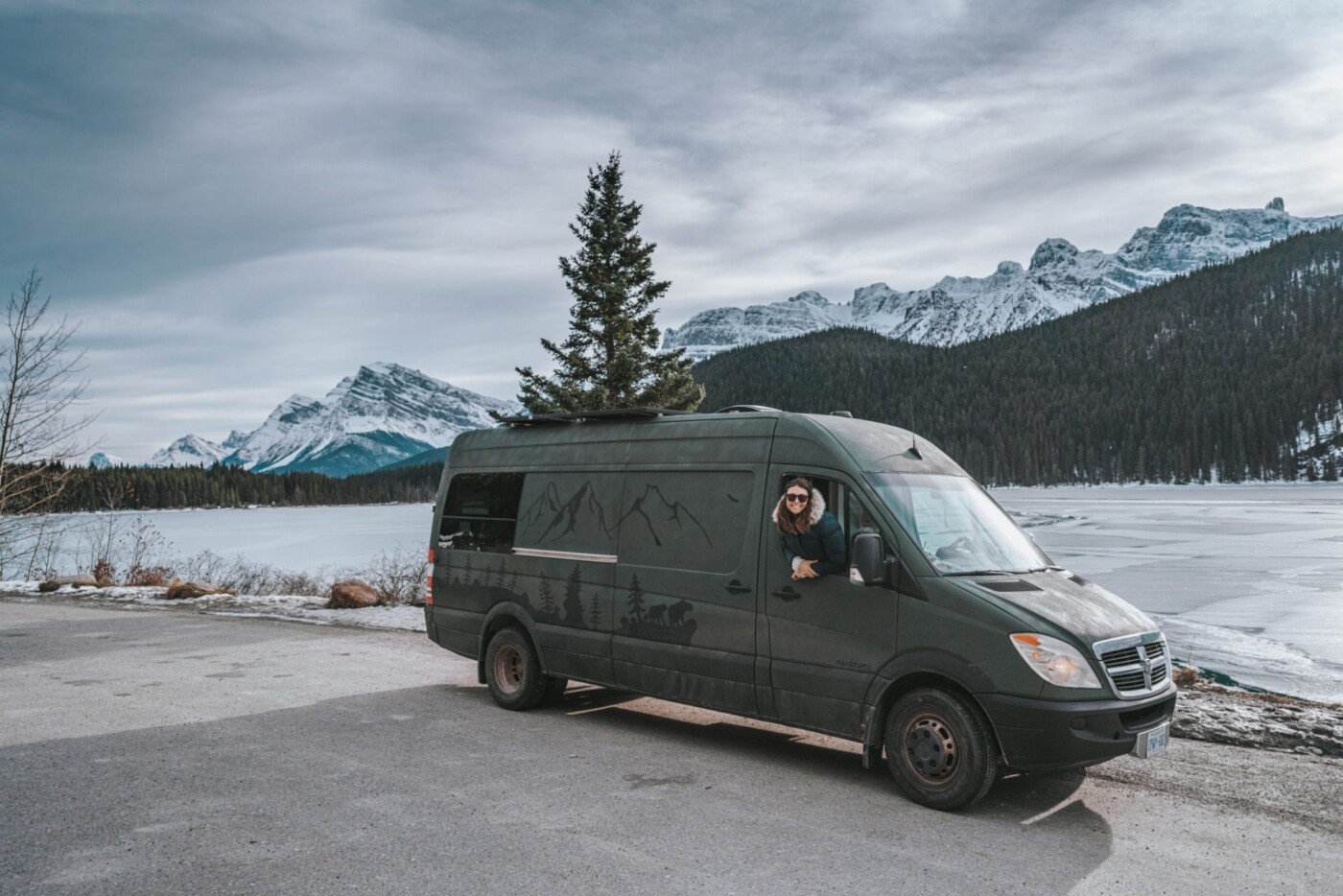
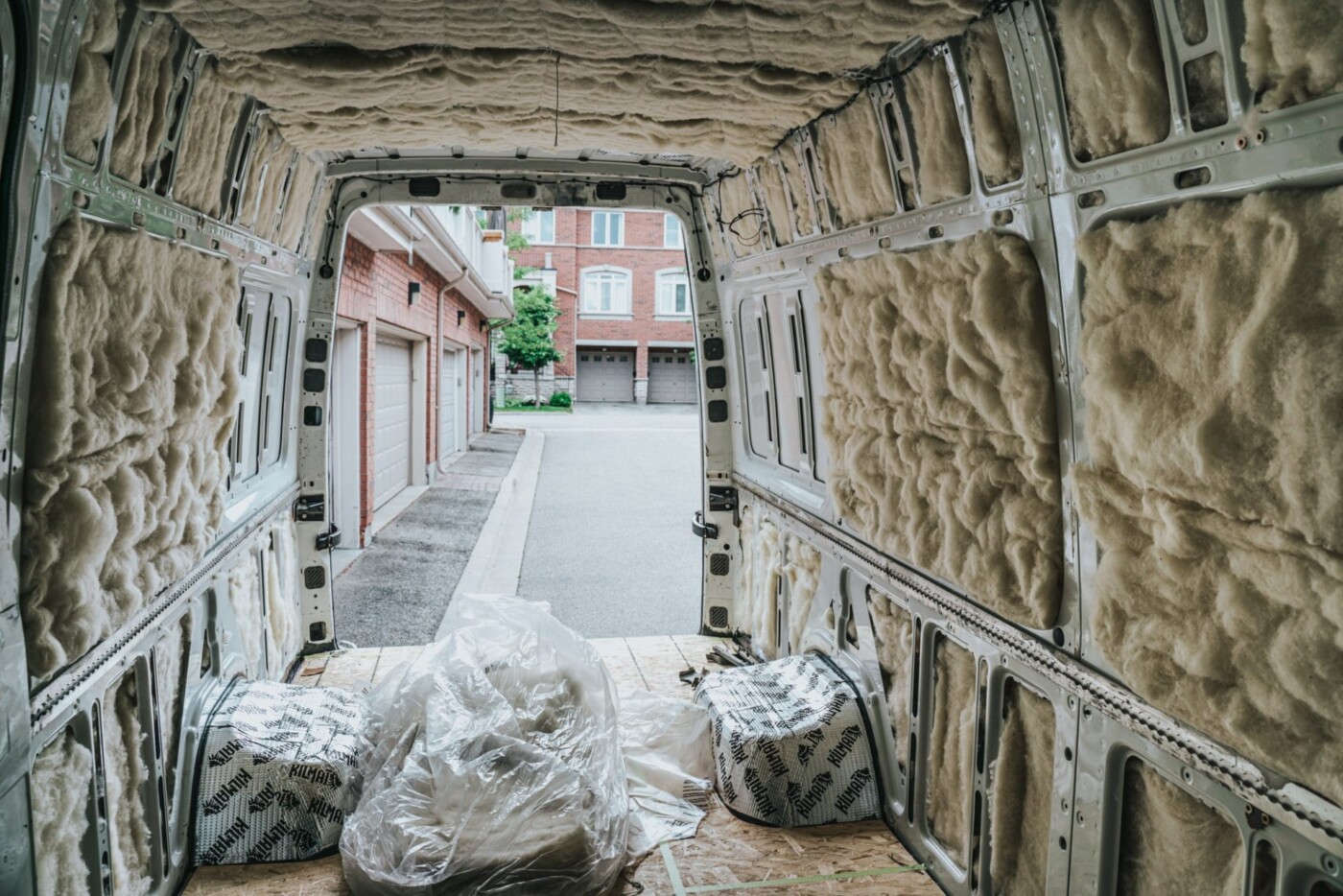
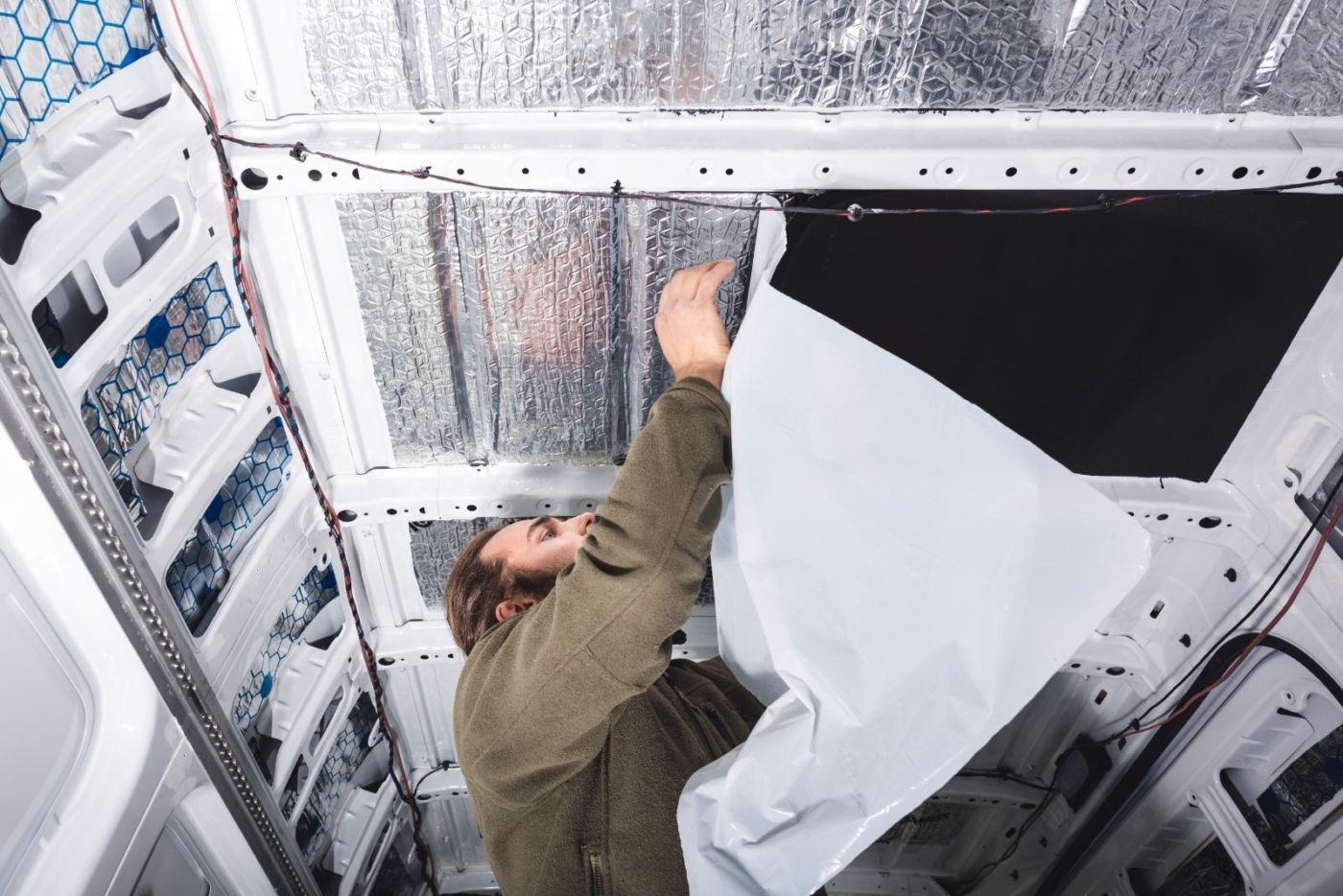
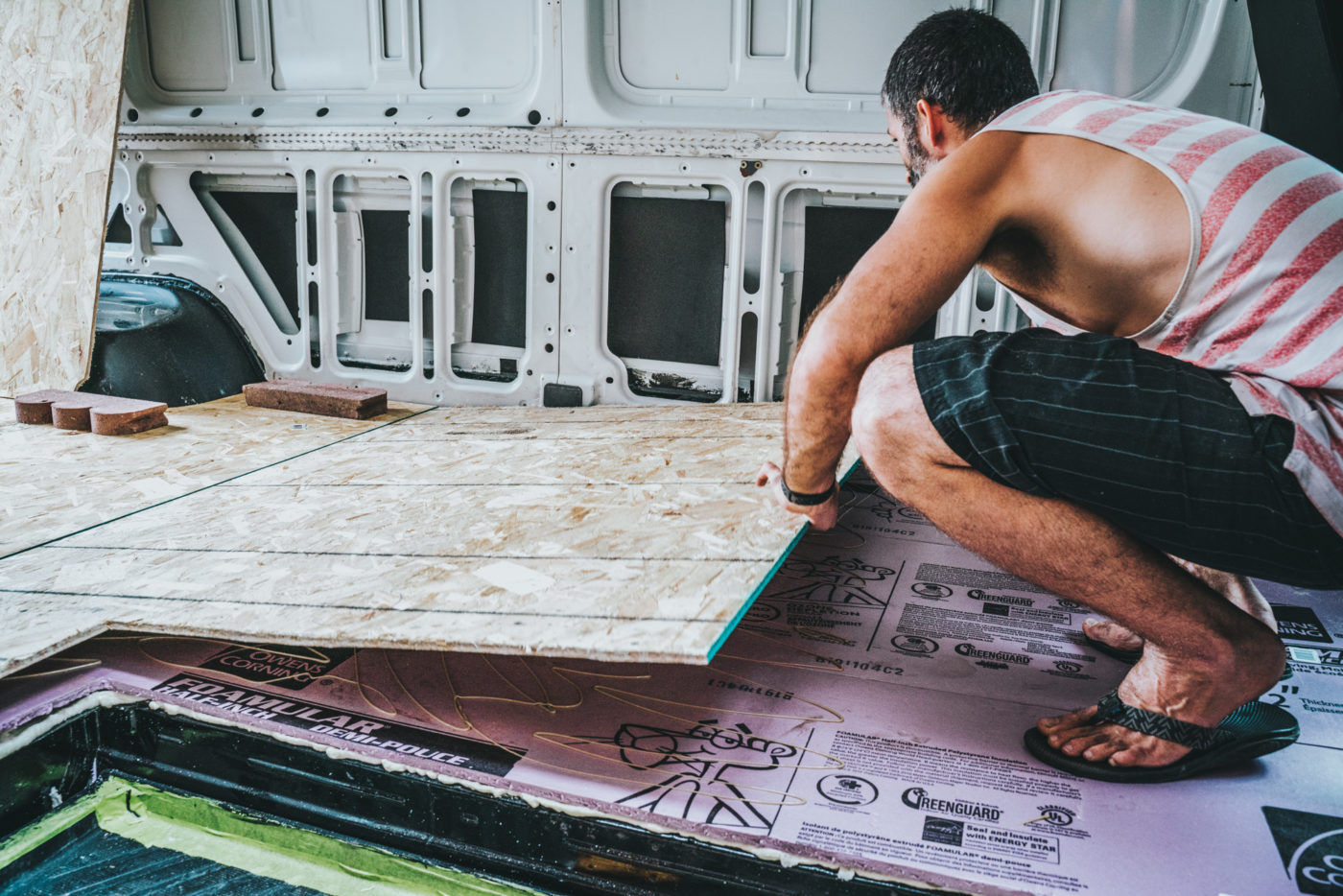
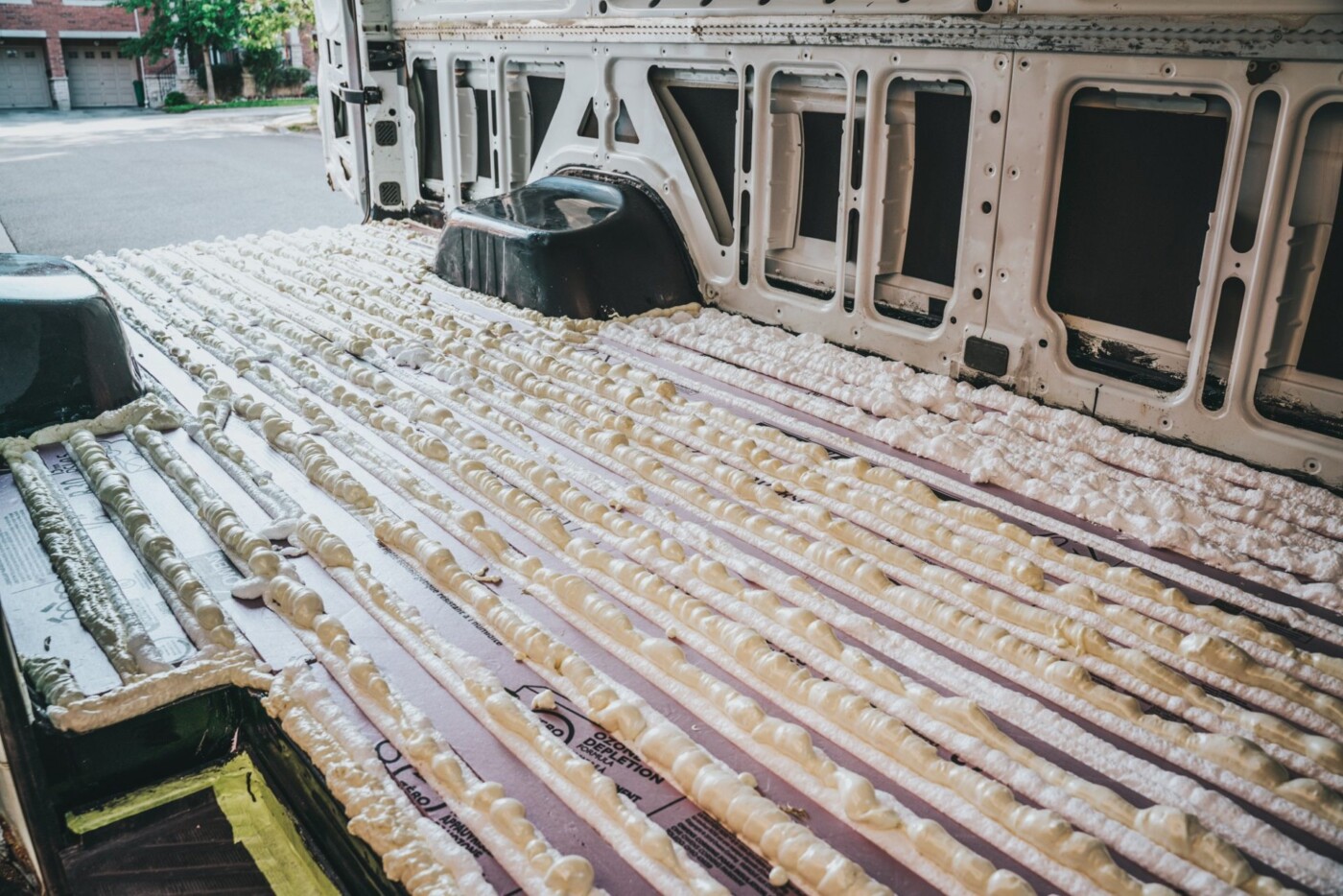
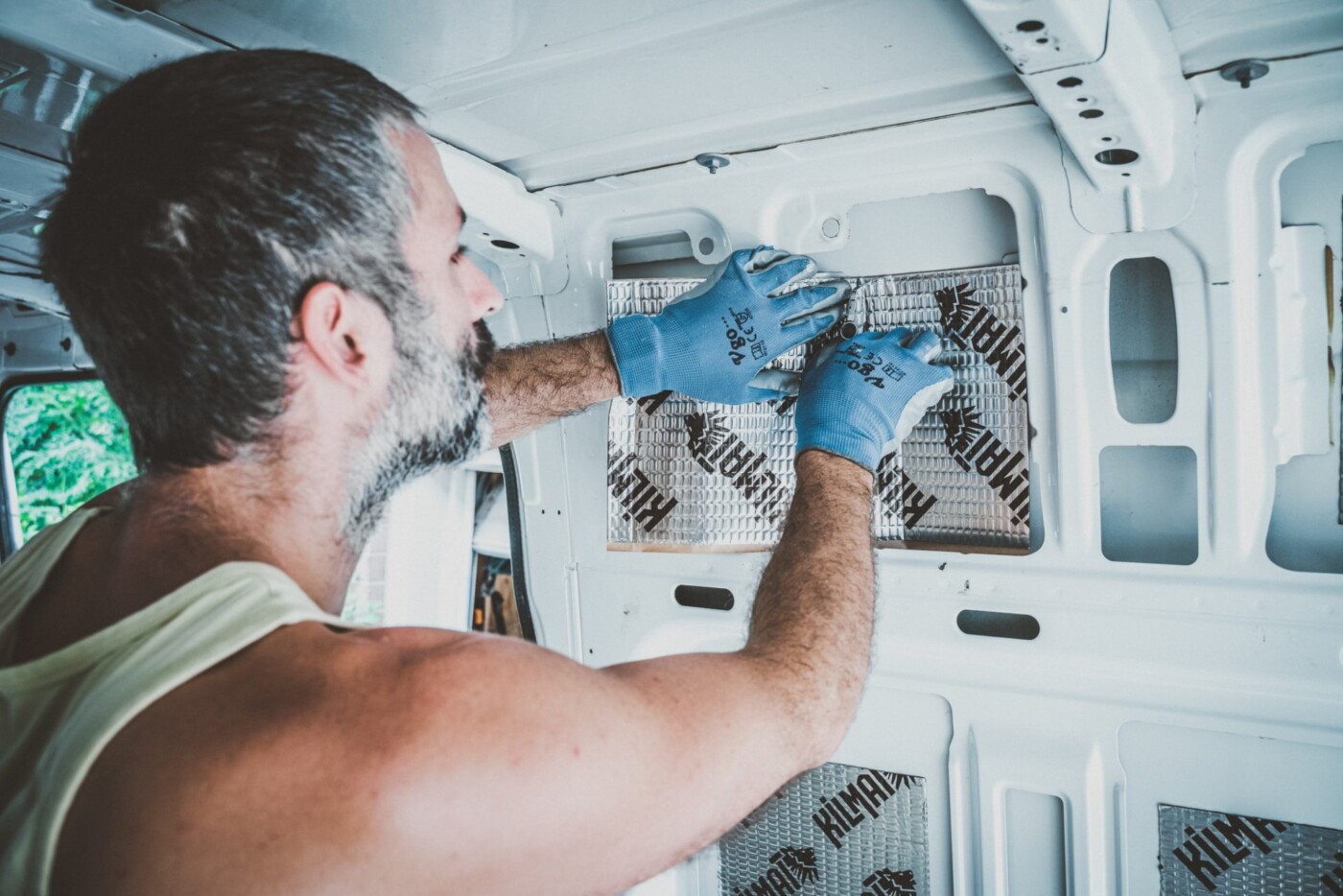


How did you level off the spray foam applied on the floor before adding the second layer of foam board?
Hi we have just bought a 2012 Renault master mobility van I have had it since June we have just put a mattress in and only been out in it twice I haven’t got a clue about conversion we only want the basics bed overhead storage sink and 2 rings to cook on I need as much help as I can I would like solar panels and mains electric hook up we are in Lincolnshire ideally I would like to put it to someone and have it all done but struggling to find someone could you help me my email address is [email protected] thankyou Dave and Karen.
Hi Dave, congrats on your purchase! Exciting times ahead! We have an article about top conversion companies that will be able to help you convert your new van into a campervan. You can find it here: https://drinkteatravel.com/best-van-conversion-companies/